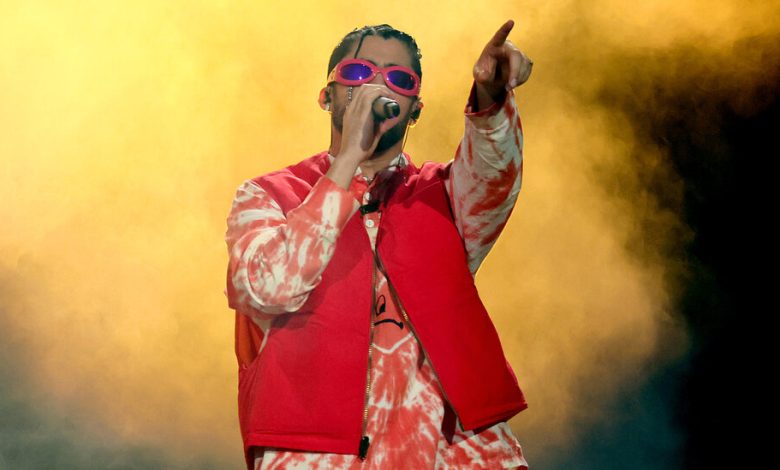Bad Bunny Anchors a Year of Explosive Growth for Latin Music

The top nominee at the 23rd annual Latin Grammy Awards on Thursday is the Puerto Rican superstar Bad Bunny, with 10 nods for “Un Verano Sin Ti,” his chart-topping, streaming-dominating release that is the year’s most popular LP.
But for the wider Latin music business, Bad Bunny is the cherry on top of an extraordinary year on streaming services and on tour, by artists including the singers Karol G, from Colombia, and Anitta, from Brazil; genre-crossing innovators like the Spanish pop disrupter Rosalía; and regional Mexican bands like Grupo Firme.
Long seen as a niche field, Latin music is continuing to penetrate fresh markets, with streaming platforms helping artists reach broad new audiences, who in turn are buying up hundreds of millions of dollars in concert tickets.
“Latin music is having a moment,” said Gary Gersh, a longtime music executive who is the president of global touring and talent for the concert company AEG Presents. “But it’s not going away. The doors have been blown off.”
In the first half of 2022, sales of Latin music recordings reached $510 million in the United States, a new peak, according to the Recording Industry Association of America, and may pass $1 billion by the end of the year. Of that total, 97 percent came from streaming — indicating an audience that is young and technologically connected. According to Spotify, half its users around the world stream at least one Latin song each month.
In the past, Latin artists were few and far between among the industry’s top tours, but that is changing. According to data from the trade publication Pollstar, the top 100 tours around the world for the first three quarters of 2022 includes 13 Latin artists who together sold $436 million in tickets — up from nine with $205 million in sales for the same period in 2019, the last comparable year before the pandemic. (Pollstar’s tracking period each year begins in late November.)
Bad Bunny, 28, is the leader of Latin’s current wave, with sales and tour numbers that routinely rival and beat English-language pop titans like Taylor Swift and Beyoncé. His latest album notched 13 weeks at No. 1 on the Billboard 200 chart, more than any other title this year. According to industry estimates, his two tours in 2022 — one hitting arenas, the other stadiums — will top the year-end global touring list with around $400 million in combined sales, putting him in the league of giants like Swift and U2.
Born Benito Antonio Martínez Ocasio, Bad Bunny — his stage name comes from a childhood costume — represents a new kind of pop star, with an eclectic style and broad, global appeal. After emerging in 2016, he built his career as a featured guest, rapping and singing on songs by artists like J Balvin and Cardi B, before releasing his first album, “X100PRE,” in 2018.
Since then he has become inescapable, appealing not only to Spanish-speaking listeners but to fans whose personal playlists may also be dotted with hip-hop, K-pop and everything else. Meanwhile, Bad Bunny has expanded into a global brand. He has an Adidas sneaker partnership, has wrestled in the W.W.E. and is set to star in the new Marvel superhero movie “El Muerto,” from Sony Pictures — while also being outspoken about political and social struggles in Puerto Rico.
“I don’t think that pop culture really has borders or language barriers anymore,” said Jbeau Lewis of United Talent Agency, who books Bad Bunny’s tours. “I don’t know that a fan necessarily draws a distinction between BTS, Taylor Swift or Bad Bunny.”
When tickets to his arena outing, El Último Tour del Mundo, were put on sale in April 2021, it became one of the fastest-selling tours in Ticketmaster’s history, and a key data point showing the industry that fans were eager to return to concerts amid the pandemic.
Lewis said that while those tickets were being sold, he could see in Ticketmaster’s back-end system that, for some shows, up to 300,000 fans were waiting to buy more — a sign of huge demand. That day, Lewis said, he called Noah Assad, Bad Bunny’s manager, and told him, “Oh man, we need to hold some stadiums for next year.”
The recent Latin touring powerhouses encompass a wide spectrum of aesthetics and traditions. Karol G, known for neon-colored wigs and her Caribbean-flavored hit “Provenza,” made a splash at Coachella in April — where she paid tribute to past Latin crossovers like “Macarena” and Daddy Yankee’s “Gasolina” — and then sold $70 million in tickets for her North American tour. That may be the biggest haul in history for a Latin female act.
Maná, a veteran Mexican rock band, played 12 times at the Kia Forum in Inglewood, Calif., as part of a residency this year, and just announced a North American arena tour for 2023. Grupo Firme, a Mexican banda group that has collaborated with pan-Latin pop stars like Camilo and Maluma, has sold $57 million in tickets in 2022, according to Pollstar.
Historically, artists singing primarily in Spanish — or any language other than English — faced a huge barrier to success when it came to radio. But streaming has provided a path around that obstacle, and many Latin acts have flourished as a result. An early indication of this shift was “Despacito,” the 2017 song by Luis Fonsi and Daddy Yankee, which became a huge hit on YouTube — though its success was partly attributable to a radio-friendly remix featuring Justin Bieber.
“The barrier is not the same as it used to be, that you had to have a song at radio so you can sell lots of tickets,” said Gersh, of AEG. “I think we are going to see more music that isn’t sung in English reaching English-speaking kids, and we’re probably going to see more English-language music reach into other countries where English isn’t the first language.”
“That, to me, is the real alternative music — it’s the alternative to the mainstream,” added Gersh, who was one of the figures who kicked off the alternative rock explosion in the 1990s by signing Nirvana to DGC Records.
Radio is still lagging behind this wave. While Bad Bunny is the king of streaming — he was the most-streamed act on Spotify in 2020 and 2021, and stands a good chance of retaining the title this year — he is only the 119th most played artist on Top 40 radio stations so far this year, according to the tracking service Mediabase.
To some extent, demographic shifts can help explain the growth of Spanish-language music. As of 2021, 19 percent of the total United States population identified as Hispanic, up from 16 percent in 2010 and just 5 percent in 1970, according to Census data and the Pew Research Center.
Those fans can straddle multiple genres and cultural spaces, said AJ Ramos, a longtime radio and streaming programmer who is the head of artist partnerships for Latin music at YouTube. Using himself as an example — born in the United States, speaking Spanish at home in a Salvadorean family, but growing up a hip-hop fan — he describes those culture-straddling fans as representing “the 200 percent.”
“You have Mexican artists like Yahritza y Su Esencia and Fuerza Regida, who embrace American culture and embrace Latin culture, living in both spaces,” Ramos said. “That audience will go from a Kendrick Lamar record to a Fuerza Regida record.” (Yahritza y Su Esencia, a trio of siblings whose Mexican family migrated to an agricultural area of Washington State, is up for two Latin Grammys, including best new artist.)
That success — enabled by streaming and social media, and now amply visible on tour — will only continue in the future, said Maykol Sanchez, an executive at Spotify who handles Latin artist and label partnerships.
“In the past, it was harder,” Sanchez said. “Today, you can have an artist from Chile that has a hit, and it happens globally on Spotify, creating a space for that artist grow bigger.”




